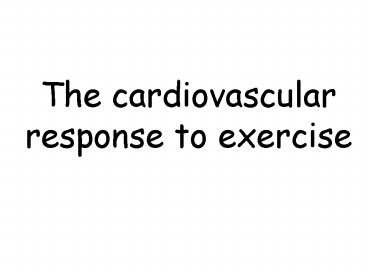The cardiovascular response to exercise PowerPoint PPT Presentation
1 / 17
Title: The cardiovascular response to exercise
1
The cardiovascular response to exercise
2
MAP CO x TPR
- Cardiac output
- Structure of the heart
- Cardiac cycle
- Control of heart rate
- Control of stroke volume
- Total peripheral resistance
- Functions of vessels
- Local control of resistance
- Central control of resistance
- Regulation of CO and TPR
- Cardiovascular changes during exercise
3
(No Transcript)
4
The cardiac cycle
5
Control of heart rate
Heart has inherent rhythmicity (100bpm) Originate
s (normally) in SA node
Sympathetic neurones Release norepinephrine
circulating epinephrine Act on b
receptors Increases heart rate
Parasympathetic neurones ( vagus) Releases
ACh Acts on muscarinic receps Slows heart rate
-
Normally, the heart is undervagal
restraint Hence resting heart rate is 70bpm
6
Control of stroke volume
Sympathetic neurones Release norepinephrine
circulating epinephrine Act on b
receptors Increases contractility Stronger
shorter systole
Parasympathetic neurones Has little/no effect on
ventricular contraction
Preload (Starlings Law)
Afterload
SV (ml)
SV (ml)
EDV (ml)
MAP (mmHg)
Strength of contraction is proportional to the
initial length of the cardiac muscle fibres
The bigger the arterial pressure the heart has
to pump against, the smaller the contraction
7
The vessels
8
Therefore varying resistance of the arterioles is
used to control a) flow through a particular
organ, and b) the perfusion pressure for the
whole body
9
Control of blood flow
Flow Pressure Difference / Resistance Vessel
radius has a massive effect (r4) on
resistance Resistance affects local blood flow
and MAP Reflected in local and central
control Arteriolar constriction (affects
resistance) vs Venoconstriction (affects
capacitance)
10
2. Central control (concerned with
maintaining MAP)
Sympathetic supply Releases norepinephrine Acts
on a receptors Causes arteriolar
constriction Reduces flow and increases MAP
Parasympathetic supply Generally has no effect
Circulating epinephrine Acts on a receptors
causes arteriolar constriction Acts on b
receptors causes arteriolar dilation Response
depends on which receptors tissue expresses
Sympathetic cholinergic vasodilators
???? Innervate skeletal muscle Cause arteriolar
dilation
11
3. External forces
eg skeletal muscle pump
contraction
eg respiratory pump
eg gravity
12
- Causes venous distension in legs
- ? VR, ? EDV, ? preload, ? SV, ? CO, ? MAP
- causes orthostatic (postural) hypotension
13
Control of CO and TPR
14
CO during exercise (cf pacemaker)
HR increases due to decreased vagal
tone increased sympathetic tone Contractility
increases due to increased sympathetic
tone circulating adrenaline EDV (preload) is
maintained by shortened systolic
phase sympathetic venoconstriction skeletal
muscle pump respiratory pump Change in
afterload? depends on balance between arteriolar
constriction (tends to increase TPR),
vs arteriolar dilation (tends to decrease TPR)
15
Blood flow during exercise
CO is redirected due to local metabolic
autoregulation in working muscle causing
arteriolar dilation offset by centrally mediated
generalised sympathetic arteriolar
constriction circulating epinephrine causes -
arteriolar constriction in most tissues (ie
those expressing a receps) - arteriolar
dilation in some tissues (ie those expressing
b receps)
16
Net result is that CO increases by 3x But blood
flow to skeletal muscle increases by 10x All
due to the coordinated response of the CVS
17
What controls these changes?
Peripheral feedback hypothesis vs Central command
hypothesis metabolic activity triggers local
arteriolar dilation - fall in TPR is sensed by
baroreceptors - these trigger reflex pressor
response - accentuated by joint receptors
chemoreceptors? but baroreflex is less sensitive
during exercise - central command causes
cardiovascular changes? probably elements of
both?

